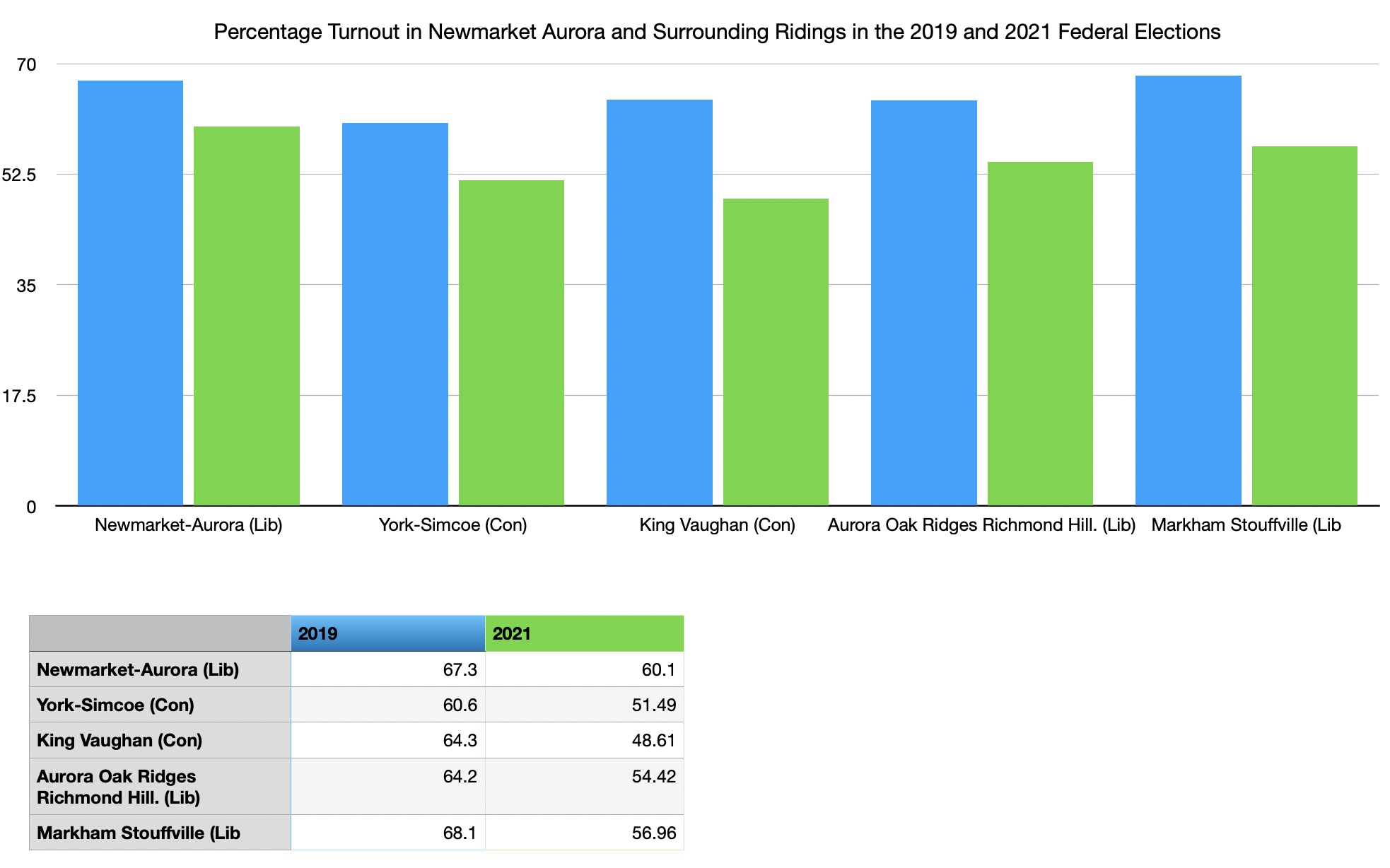The collapse in voter turnout is worse than I thought.
It has shrunk alarmingly in Newmarket-Aurora and in all surrounding ridings. 
As I tap this out at 7.40pm on 23 September 2021 the counts have been completed in Newmarket-Aurora; Aurora-Oak Ridges-Richmond Hill and King-Vaughan. We are waiting for the final results from Markham-Stouffville and York-Simcoe.
But the pattern is very clear. Voter turnout is sharply down across the piece.
Astonishingly, in King-Vaughan fewer than half of electors stirred themselves to vote.
Big reductions in the number of polling places
Newmarket-Aurora's Returning Officer tells me:
"We have less than half of the voting sites than we did for the 2019 election. Specifically, we have not been given access to any schools. Previously we had 45 voting locations; this election we have 25 sites (not including single building polls)."
On Polling Day I voted in person at a Church on Main Street South, about two kilometres from where I live. There is no direct bus route from my neighbourhood to my Polling Place in Newmarket's downtown.
At the Polling Station I notice a comment box from Elections Canada, asking about my voting experience. I scribble out a note saying the polling place is too far away from my neighbourhood and this would have discouraged some people from voting.
Yesterday, I received a commendably swift reply from the Riding’s Returning Officer.
Challenging
She tells me it was an
“extraordinarily challenging election”.
I agree.
She goes on to say:
“There has been no evidence that the location of polling sites has discouraged voters.”
On that one, though, we have to disagree.
If it wasn't the savage reduction in voting sites that kept people away from voting, what was it?
The pandemic? Disaffection? Couldn't be bothered?
The table below shoes the voter turnout in Newmarket-Aurora and in all adjacent ridings, comparing the 2019 and 2021 Federal Elections.
This email address is being protected from spambots. You need JavaScript enabled to view it.
Updated on 25 September 2021. All counts have now been completed. The reported turnouts are as shown below.
And the Toronto Star's editorial on low turnouts

From the Returning Officer, Newmarket-Aurora. 22 September 2021
Thank you for your voter feedback. You noted concern at the distance for the polls. A number of variables occurred this election, namely:
A number of factors have made this an extraordinarily challenging election. Namely:
- We have less than half of the voting sites than we did for the 2019 election. Specifically, we have not been given access to any schools. Previously we had 45 voting locations; this election we have 25 sites (not including single building polls).
- We are required, by law, to have fully accessible sites, near public transit.
- Due to pandemic guidelines we were unable to put as many polls in each location (distancing guidelines), and as we have less sites, we have had to allocate more voters to each site. As an example, most polls had 400 voters assigned to it last election. This election there were 1,000 voters assigned to most polls.
- It should be noted that northern Canada polling sites, and rural sites, often drive many kilometres, in fact hours, to a polling station. A two kilometre distance is not considered onerous.
The Canada Elections Act does not specify the distance a polling site needs to be from electors. In non-pandemic times, we do our best to accommodate polling sites close to electors as a courtesy. The Act does not specify neither distance to the polls, nor length of time an elector should wait in line.
There has been no evidence that the location of polling sites has discouraged voters. We experienced a marked increase in both special ballot voting, and mail in voting, Our office was open from August 15 - September 14, 2021, 12-hours a day (on Monday - Friday), and seven days a week, for voting. The advance polls operated over four days, 12-hours a day, and also saw a significant increase in voter turnout. Electors had 32 days to vote.
On election day each elector had access to a fully accessible voting location, close to public transit, with service available in both official language.
